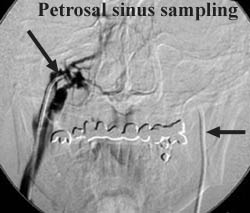 The pituitary gland is located at the base of the brain. Many pituitary tumors produce hormones that cause symptoms (the symptoms depend on which hormone is produced). These symptoms may appear before the tumor is large enough to put pressure on surrounding structures, sometimes before the tumor is large enough to be seen on an MRI or CT scan. Blood tests will reveal high levels of the hormone. If a tumor is suspected but cannot be seen, a test can be performed to see if the hormone is coming from the pituitary gland. This is called petrosal sinus sampling.
The pituitary gland is located at the base of the brain. Many pituitary tumors produce hormones that cause symptoms (the symptoms depend on which hormone is produced). These symptoms may appear before the tumor is large enough to put pressure on surrounding structures, sometimes before the tumor is large enough to be seen on an MRI or CT scan. Blood tests will reveal high levels of the hormone. If a tumor is suspected but cannot be seen, a test can be performed to see if the hormone is coming from the pituitary gland. This is called petrosal sinus sampling.
The petrosal sinuses are the veins at the base of the skull that drain the pituitary. A catheter is placed into a vein in each leg (like for an angiogram of the heart) and threaded up into the jugular vein on either side of the neck. A tiny catheter is then threaded through each of these catheters into the petrosal sinus on both sides of the pituitary gland. Blood samples are taken from both catheters, as well as from the blood circulating through the body to measure the levels of the hormone. A drug can be given to make the pituitary gland produce more of the hormone if necessary. The patient can go home later the same day. If the tests reveal that the blood from the pituitary has higher levels of the hormone than the rest of the body, then a tiny tumor is probably present. If one side is higher than the other, the tumor is on that side of the gland. The surgeon can then find the tumor to remove it.